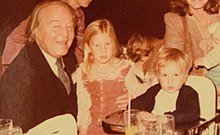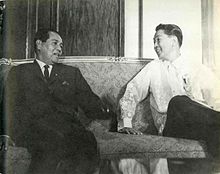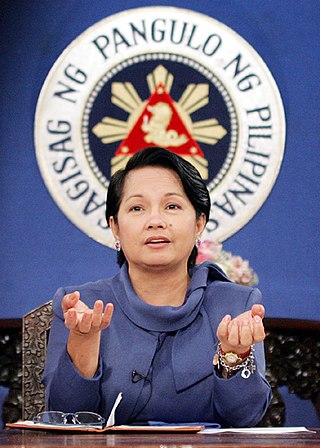
Maria Gloria Macaraeg Macapagal-Arroyo, often referred to by her initials PGMA and GMA, is a Filipino academic and politician who previously served as the 14th President of the Philippines from 2001 to 2010. She is the longest serving president of the Philippines since Ferdinand Marcos. Before her accession to the presidency, she served as the 10th Vice President of the Philippines from 1998 to 2001 under President Joseph Ejercito Estrada, making her the country's first female vice president, despite having run on an opposing ticket. She was also a Senator from 1992 to 1998. After her presidency, she was elected as the Representative of Pampanga's 2nd district in 2010 and later became the Speaker of the House of Representatives on 2018 to 2019. She was also serving in the congress as a Deputy Speaker from 2016 to 2017 and from 2022 until 2023. She is one of the only 2 Filipinos to hold at least three of the four highest offices in the country: vice president, president, and house speaker, alongside former President Sergio Osmeña.
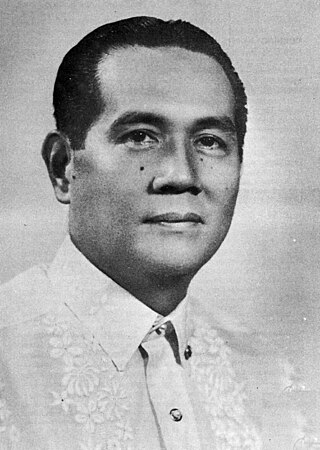
Diosdado Pangan Macapagal was a Filipino lawyer, poet and politician who served as the ninth President of the Philippines, serving from 1961 to 1965, and the sixth Vice President, serving from 1957 to 1961. He also served as a member of the House of Representatives, and headed the Constitutional Convention of 1970. He was the father of Gloria Macapagal Arroyo, who followed his path as President of the Philippines from 2001 to 2010.

Jovito Reyes Salonga, KGCR also called "Ka Jovy," was a Filipino politician and lawyer, as well as a leading opposition leader during the regime of Ferdinand Marcos from the declaration of martial law in 1972 until the People Power Revolution in 1986, which removed Marcos from power. Salonga was the 14th president of the Senate of the Philippines, serving from 1987 to 1992.

The Second EDSA Revolution, also known as the Second People Power Revolution, EDSA 2001, or EDSA II, was a political protest from January 17–20, 2001 which peacefully overthrew the government of Joseph Estrada, the thirteenth president of the Philippines. Following allegations of corruption against Estrada and his subsequent investigation by Congress, impeachment proceedings against the president were opened on January 16. The decision by several senators not to examine a letter which would purportedly prove Estrada's guilt sparked large protests at the EDSA Shrine in Metro Manila, and calls for Estrada's resignation intensified in the following days, with the Armed Forces withdrawing their support for the president on January 19. On January 20 Estrada resigned and fled Malacañang Palace with his family. He was succeeded by Vice President Gloria Macapagal Arroyo, who had been sworn into the presidency by Chief Justice Hilario Davide Jr. several hours earlier.

Jose Maria Canlas Sison, also known as Joma, was a Filipino writer, poet, and activist who founded and led the Communist Party of the Philippines (CPP) and added elements of Maoism to its philosophy—which would be known as National Democracy. His ideology was formed by applying Marxism–Leninism–Maoism to the history and circumstances of the Philippines.

The Department of Justice is under the executive department of the Philippine government responsible for upholding the rule of law in the Philippines. It is the government's principal law agency, serving as its legal counsel and prosecution arm. It has its headquarters at the DOJ Building in Padre Faura Street, Ermita, Manila.
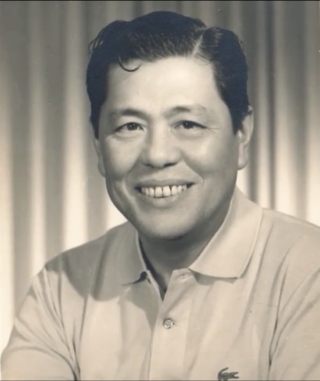
Jose Wright Diokno, also known as "Ka Pepe", was a Filipino nationalist, lawyer, and statesman. Regarded as the "Father of Human Rights," he served as Senator of the Philippines, Secretary of Justice, founding chair of the Commission on Human Rights, and founder of the Free Legal Assistance Group (FLAG), the premier group of Filipino human rights lawyers. Diokno is the only person to top both the Philippine Bar Examination and the board exam for Certified Public Accountants (CPA). His career was dedicated to the promotion of human rights, the defense of Philippine sovereignty, and the enactment of pro-Filipino economic legislation.

This article covers the history of the Philippines from the recognition of independence in 1946 to the end of the presidency of Diosdado Macapagal that covered much of the Third Republic of the Philippines, which ended on January 17, 1973, with the ratification of the 1973 Constitution of the Republic of the Philippines.
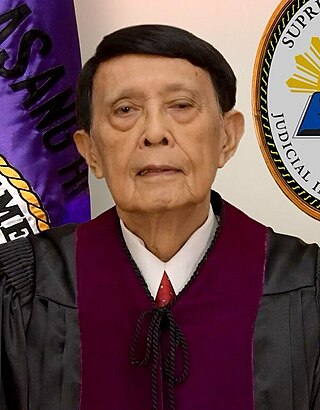
Romeo J. Callejo Sr. was the 152nd associate justice of the Supreme Court of the Philippines. He was appointed to the court on August 26, 2002, by President Gloria Macapagal Arroyo, and served until his mandatory retirement on April 27, 2007.

Roberto Reyes Concepcion was the Chief Justice of the Supreme Court of the Philippines from June 17, 1966 until April 18, 1973. He is remembered in the history of the Philippine Supreme Court for protecting the independence of court, and for having fought decisions which would have legitimized the dictatorship of President Ferdinand Marcos. In recognition of his efforts against authoritarian rule, Concepcion's name was inscribed on the Wall of Remembrance at the Bantayog ng mga Bayani in 1994.
The Philippine Bar Examinations is the professional licensure examination for lawyers in the Philippines. The exam is exclusively administered by the Supreme Court of the Philippines through the Supreme Court Bar Examination Committee.
Alfredo Logronio Benipayo is the former Dean of the University of Santo Tomas Faculty of Civil Law, the oldest law school in the Philippines. He is a former magistrate and a respected law professor and bar reviewer in the country.
The trial of Philippine president Joseph Estrada took place between 2001 and 2007 at the Sandiganbayan. Estrada, popularly called Erap, was resigned from office in 2001 during a popular uprising in Metro Manila after an aborted impeachment trial in which he was charged with plunder and perjury. Soon after his ouster, the same charges were filed against him at the Sandiganbayan.

Arsenio Hilario Sison Lacson Sr. was a Filipino lawyer, journalist and politician who gained widespread attention as 1st to be elected and 17th Mayor of Manila from 1952 to 1962. An active executive likened by Time and The New York Times to New York City's Fiorello La Guardia, he was the first Manila mayor to be reelected to three terms. Nicknamed "Arsenic" and described as "a good man with a bad mouth", Lacson's fiery temperament became a trademark of his political and broadcasting career. He died suddenly from a stroke amidst talk that he was planning to run in the 1965 presidential election.
Abraham Florendo Sarmiento Sr. was a Filipino jurist who served as an Associate Justice of the Supreme Court of the Philippines from 1987 to 1991. An active figure in the political opposition against the martial law government of President Ferdinand Marcos, he was appointed to the Court by Marcos' successor, President Corazon Aquino.
The Fertilizer Fund scam is a Philippine political controversy involving accusations that Agriculture Undersecretary Jocelyn Bolante diverted ₱728 million in fertilizer funds to the 2004 election campaign of President Gloria Macapagal Arroyo.

The Philippines suffers from widespread corruption, which developed during the Spanish colonial period. According to GAN Integrity's Philippines Corruption Report updated May 2020, the Philippines suffers from many incidents of corruption and crime in many aspects of civic life and in various sectors. Such corruption risks are rampant throughout the state's judicial system, police service, public services, land administration, and natural resources.

Jose Manuel Tadeo "Chel" Icasiano Diokno is a Filipino lawyer, educator, human rights advocate, and broadcaster. He serves as chairman of the Free Legal Assistance Group (FLAG), the founding dean of the De La Salle University College of Law, and the chairman of the Bantayog ng mga Bayani Foundation. He has served as a special counsel of the Senate Blue Ribbon Committee. He was a candidate for the Senate in 2019 and 2022. He also co-hosts radio programs such as Oras at Bayan on Veritas 846 and Rekta: Agenda ng Masa on DZRH and DZRH News Television.
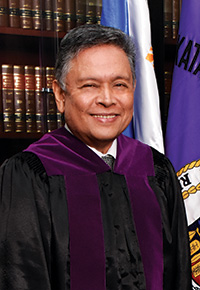
Noel Gimenez Tijam is a Filipino lawyer who served as an associate justice of the Supreme Court of the Philippines from March 8, 2017 to January 5, 2019. Prior to his appointment, he was a justice of Court of Appeals from 2003 to 2017.

Guillermo Flavier Pablo was a Filipino jurist and politician who served as an Associate Justice of the Supreme Court from 1945 to 1955. He had earlier served as a member of the House of Representatives of the Philippines, representing the Lone District of Zambales from 1916 to 1922.

